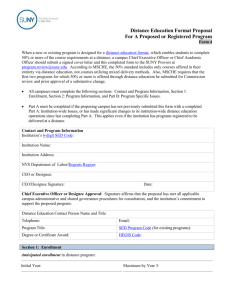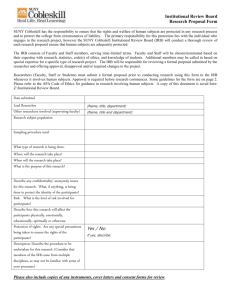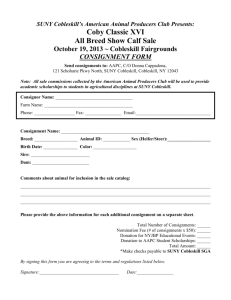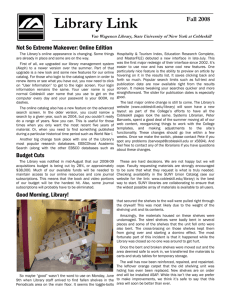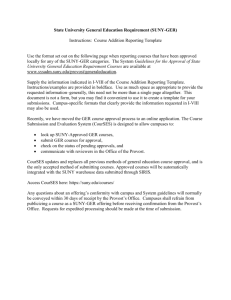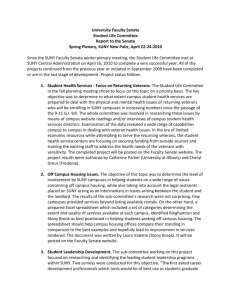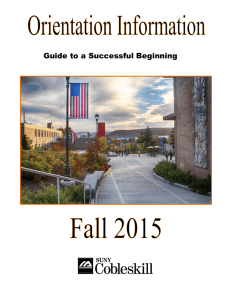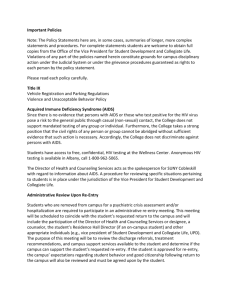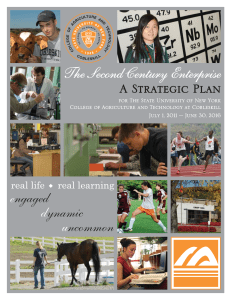Community Engagement
advertisement
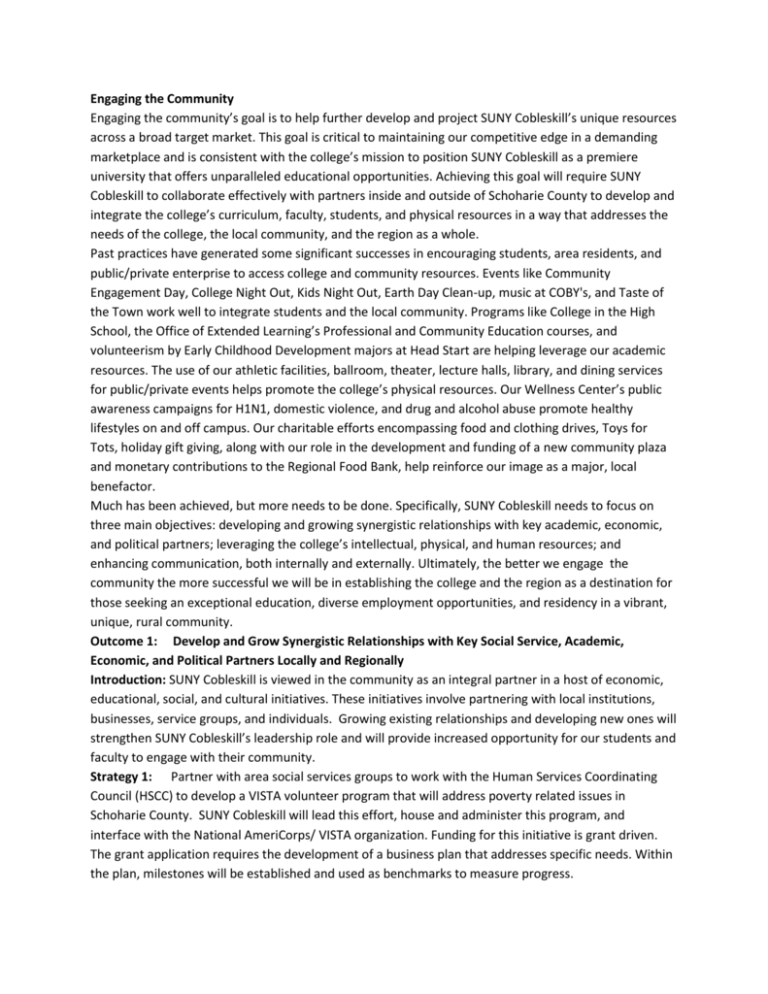
Engaging the Community Engaging the community’s goal is to help further develop and project SUNY Cobleskill’s unique resources across a broad target market. This goal is critical to maintaining our competitive edge in a demanding marketplace and is consistent with the college’s mission to position SUNY Cobleskill as a premiere university that offers unparalleled educational opportunities. Achieving this goal will require SUNY Cobleskill to collaborate effectively with partners inside and outside of Schoharie County to develop and integrate the college’s curriculum, faculty, students, and physical resources in a way that addresses the needs of the college, the local community, and the region as a whole. Past practices have generated some significant successes in encouraging students, area residents, and public/private enterprise to access college and community resources. Events like Community Engagement Day, College Night Out, Kids Night Out, Earth Day Clean-up, music at COBY's, and Taste of the Town work well to integrate students and the local community. Programs like College in the High School, the Office of Extended Learning’s Professional and Community Education courses, and volunteerism by Early Childhood Development majors at Head Start are helping leverage our academic resources. The use of our athletic facilities, ballroom, theater, lecture halls, library, and dining services for public/private events helps promote the college’s physical resources. Our Wellness Center’s public awareness campaigns for H1N1, domestic violence, and drug and alcohol abuse promote healthy lifestyles on and off campus. Our charitable efforts encompassing food and clothing drives, Toys for Tots, holiday gift giving, along with our role in the development and funding of a new community plaza and monetary contributions to the Regional Food Bank, help reinforce our image as a major, local benefactor. Much has been achieved, but more needs to be done. Specifically, SUNY Cobleskill needs to focus on three main objectives: developing and growing synergistic relationships with key academic, economic, and political partners; leveraging the college’s intellectual, physical, and human resources; and enhancing communication, both internally and externally. Ultimately, the better we engage the community the more successful we will be in establishing the college and the region as a destination for those seeking an exceptional education, diverse employment opportunities, and residency in a vibrant, unique, rural community. Outcome 1: Develop and Grow Synergistic Relationships with Key Social Service, Academic, Economic, and Political Partners Locally and Regionally Introduction: SUNY Cobleskill is viewed in the community as an integral partner in a host of economic, educational, social, and cultural initiatives. These initiatives involve partnering with local institutions, businesses, service groups, and individuals. Growing existing relationships and developing new ones will strengthen SUNY Cobleskill’s leadership role and will provide increased opportunity for our students and faculty to engage with their community. Strategy 1: Partner with area social services groups to work with the Human Services Coordinating Council (HSCC) to develop a VISTA volunteer program that will address poverty related issues in Schoharie County. SUNY Cobleskill will lead this effort, house and administer this program, and interface with the National AmeriCorps/ VISTA organization. Funding for this initiative is grant driven. The grant application requires the development of a business plan that addresses specific needs. Within the plan, milestones will be established and used as benchmarks to measure progress. Measure: Bi monthly meetings with HSCC beginning in April, 2010. Grant submission, February 2011. Strategy 2: Strengthen the partnership with the public school system and showcase SUNY Cobleskill’s resources to prospective college students by developing a “College Discovery Symposiums/Workshops & Camps” with programming that features our most unique, marketable resources, which could include the new bio-waste engineering, aqua-culture, and hydroponics programs. A marketing program targeting students, educators, industry executives, and government officials will be developed and implemented to support this initiative. Measure: Host first symposium in the summer/fall of 2011. Track number of participants and financial sustainability. Strategy 3: Embrace the Tech Valley initiative being spearheaded by the Center for Economic Growth in conjunction with Global Foundries and GE by convening a task force that will meet with representatives from CEG, Global Foundries, GE and High School guidance counselors to determine what existing course offerings could be packaged and marketed to meet the training and employment needs of the high tech job sector. Measure: Begin monthly meetings in June of 2010 to determine the feasibility of launching this initiative. Strategy 4: Develop an internship program to assist local economic development organizations such as the Cobleskill Partnership, Chamber of Commerce and Cooperative Extension deliver on their respective missions. Measure: Solicit candidates through Career Development office, interview top candidates and make final selection by May of 2010. Implementation by June, 2010. Strategy 5: Work with the Business Administration Department to develop “real world” business plans targeting, specific vacant properties. Create a “board of directors” consisting of faculty, business professionals, lenders and government officials to serve in an advisory capacity to support business development. Measure: Initial, internal meeting in April of 2010. Begin process of building consensus amongst key partners. Have the board of directors and business plan concept in place for the fall of 2010. Strategy 6: Educate and engage students as consumers of local products and services. Measure: Develop plans during the summer of 2010 to promote a "business of the month" on campus: replicate the ‘Taste of the Town” initiative featuring local businesses on student arrival day, work with CSA to develop a county wide “Great Race/Scavenger Hunt” that will engage students with local businesses. Convene a student focus group to work with local businesses to help promote student patronage. Outcome 2: Leverage the College’s Intellectual, Physical, and Human Resources by Expanding the Use of Campus Facilities by Outside Groups. Introduction: SUNY Cobleskill possesses a wide variety of valuable facility space. The campus’s classrooms, kitchens, working farm, equestrian center, gymnasium, theater, fitness center, bowling alleys, pool, and dormitories can be utilized by groups for meetings, conferences and other events. Under-utilized campus facilities provide an opportunity for SUNY Cobleskill to enhance revenue by hosting a variety of events such as conferences, conventions, expos, meetings, animal clinics, family reunions, and seminars. Strategy 1: Develop a targeted marketing plan to promote the use of college facilities for events, corporate training, and education. Work with faculty, staff, local businesses, and government to uncover opportunities to leverage current memberships, affiliations, attendance at trade shows etc. into events that can be hosted at SUNY Cobleskill. Measure: Develop prospect list and marketing strategy by end of semester Fall 2010. Strategy 2: Promote the library as a public resource for research, education, and cultural activities: receptions, art exhibits, book signings, chamber music concerts etc. Measure: Develop programming and marketing plan for implementation by Fall 2010. Strategy 3: Co-sponsor events/marketing with regional tourist attractions e.g. Fairgrounds, Howe Caverns, and Cooperstown. Develop “Rack Card” type promotional material on SUNY Cobleskill for distribution at these and other key tourist attractions. Invite representatives from these attractions to participate in business promotional events on campus. Measure: Conduct initial feasibility study/develop partnerships June of 2011. Bring at least two additional events per semester to campus. Increase summer space use as allowed by our facilities and programs. Increase revenue to the various areas of the college as well as the college overall. Outcome 3: Enhance Communication of College Events and Resources Internally and Externally. Introduction: Existing programming at SUNY Cobleskill is extensive and crosses all departments. Communicating these activities internally and externally given the multiplicity of print and electronic media represents an ongoing challenge. Internal Strategies Strategy 1: Create and maintain a streamlined, current campus event calendar that includes athletics, student life, alumni events, and general campus events. Measure: Have comprehensive calendar functional by Fall of 2010. Strategy 2: Develop a list of “text able” students and faculty, particularly RAs, who can serve as conduits to communicate and increase attendance at campus and community events. Track attendance at events. Measure: Work with RA Council in Fall 2010 and Spring of 2011 to develop list of “text ready” Students. Track number of participants. Strategy 3: Construct an on campus Kiosk to post on and off campus events and transportation options. Measure: Work with facilities in the summer of 2011 to design, locate, and install a Kiosk by the fall of 2011. Track attendance at events. External Strategies Strategy 5: Update and streamline our website to create faster and more intuitive browsing for all users including students, parents, faculty, alumni, staff and the community. (Update Around Town offerings, Banner Ads/On and Off Campus Events, add video component/links). Measure: Meetings in April of 2010 are underway to identify and allocate the resources necessary to revise and maintain an enhanced website by the fall of 2010. Track number of hits to web site. Strategy 6: Broaden our target market to include under-solicited border communities, e.g. Worcester, Berne-Knox-Westerlo, Delanson, and Canajoharie that consider Cobleskill a viable alternative to Oneonta and the Capital District for education and recreation. Measure: Increase advertizing in “community” publications to supplement mainstream media publicity. Broaden public awareness. Strategy 7: Maintain memberships in strategic organizations outside of the county (Chambers, Hospital Boards, Economic Development Groups, etc.). Leverage those groups’ memberships to develop targeted mailing/e-mail lists. Measure: Review and update this list, adding strategic partnerships as necessary. Broaden public awareness. Strategy 8: Continue and seek to expand the President’s roundtable breakfast and “38 at 38” events so that the President is engaged with groups of business leaders, residents, politicians, students, and faculty on a monthly basis. Use these opportunities to seek input on and support for the marketing of college/community initiatives. Measure: Schedule monthly meetings beginning Summer of 2010. Strategy 9: Develop a speakers' bureau that will address local clubs and service groups (Rotary, Lions, Exchange Club, Church groups etc.) that are looking for programming. Measure: Solicit speakers and develop a series for the fall of 2010. Track speaker bureau requests and obtain evaluation forms.
